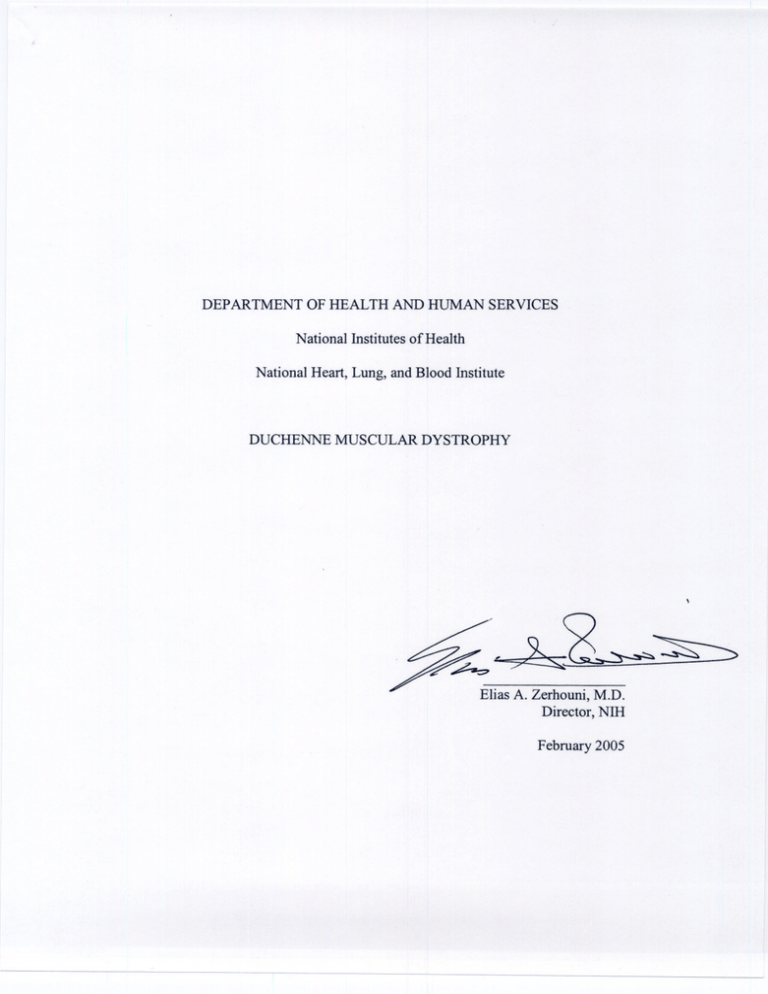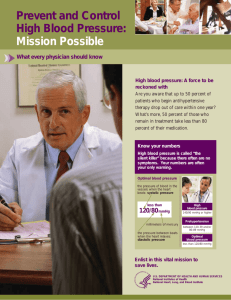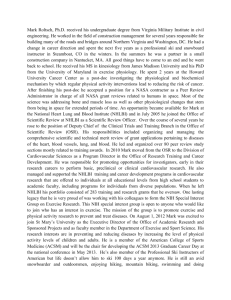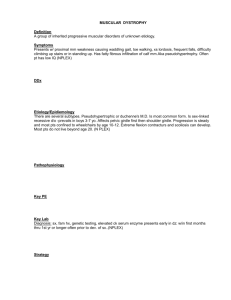Duchenne Muscular Dystrophy Report
advertisement

DEPARTMENT OF HEALTH AND HUMAN SERVICES National Institutes of Health National Heart, Lung, and Blood Institute DUCHENNE MUSCULAR DYSTROPHY Elias A. Zerhouni, M.D. Director, NIH February 2005 DUCHENNE MUSCULAR DYSTROPHY Introduction In their reports on the fiscal year 2005 budget for the Department of Health and Human Services (DHHS), the Senate Committee on Appropriations and the House Committee on Appropriations stated: “The Committee encourages the NHLBI, in collaboration with the Office of Rare Diseases, to enhance the research and related activities surrounding pulmonary and cardiac complications associated with Duchenne muscular dystrophy. The NHLBI is expected to report to the Committee on its approach to this issue not later than January 15, 2005.” (Senate Report 108-345, page 105) “The Committee encourages the NHLBI, in collaboration with the Office of Rare Diseases, to enhance the research and related activities surrounding pulmonary and cardiac complications associated with Duchenne muscular dystrophy. The Committee requests that the NHLBI report to the Committee on its approach to this issue not later than January 15, 2005.” (House Report 108-636, pages 70-71) The following report was prepared by the National Heart, Lung, and Blood Institute (NHLBI), National Institutes of Health (NIH), DHHS, in response to this request. Background Muscular dystrophies affect tens of thousands of people in the United States. The most common form, Duchenne muscular dystrophy, occurs in approximately one of every 3,500 newborn boys. It is characterized by progressive weakness in muscles of the legs and trunk, which generally causes difficulties by elementaryschool age and requires wheelchair use by adolescence. The breathing muscles are also affected, and most patients ultimately need ventilatory support. Respiratory infections are an ever-present threat and, ultimately, respiratory failure is the cause of death in the majority of cases. With improvements in respiratory care in recent years, more attention is now being focused on other manifestations such as cardiomyopathy, a disease of the heart muscle. The heart loses its ability to pump blood and, in some instances, heart rhythm is disturbed, leading to irregular heartbeats or arrhythmias. Pulmonary symptoms also develop, such as shortness of breath and fluid accumulation or congestion in the lungs. The NHLBI supports an active program of basic and clinical research relevant to cardiomyopathy, and works with the 1 Muscular Dystrophy Coordinating Committee (MDCC) to integrate its activities with muscular dystrophy research supported by other NIH Institutes and Centers. Plans to Enhance Research The NHLBI and the Office of Rare Diseases (ORD), which also is represented on the MDCC, plan to convene a working group on Cardiomyopathies of Rare Diseases in the spring of 2005. About a dozen scientists, clinicians, and patient advocates with expertise and interest in cardiomyopathies associated with rare diseases (e.g., muscular dystrophies, X-linked dilated cardiomyopathy, and Barth syndrome) will be invited to attend. Participants will discuss the current state of the science and identify research questions that need to be answered and potential therapeutic strategies that should be investigated. A key issue for discussion is why childhood cardiomyopathies have been resistant to advances in treatment, and participants will be asked to make recommendations to the NHLBI and the ORD about future research directions that can be pursued to overcome this hurdle. The MDCC will serve as a forum through which the NHLBI and ORD can inform other NIH components about opportunities for collaborations related to cardiovascular aspects of Duchenne muscular dystrophy that participants identified, and the NHLBI will work with group members to disseminate the recommendations, possibly via submission of a summary for publication into a peer-reviewed journal. The group is likely to address emerging strategies (e.g., cell-based therapies, regenerative medicine, gene therapy) for treating cardiomyopathies associated with rare diseases. Thanks to the recent doubling of the NIH budget, the NHLBI has already been able to develop resources that will facilitate implementation of recommendations in these areas. For example, the NHLBI Programs of Excellence in Gene Therapy can provide investigators with pre-clinical and clinical quality vectors, purified human or non-human primate hematopoietic stem cells, and the services of non-human primate stem cell transplantation and cell morphology cores. The NHLBI also funds three cell-processing centers to provide consulting, manufacturing, and regulatory services as a resource for investigators developing clinical projects in cell-based therapy. Moreover, the NHLBI has been involved in several trans-NIH activities related to cell-based therapies, including the establishment of short-term courses for embryonic stem cell culture techniques. The meeting will not be the first collaboration on cardiomyopathy between the NHLBI and the ORD. In May 2004, the NHLBI, the ORD, and the American Heart Association cosponsored a conference, titled Inflammation and Immunity in Dilated Cardiomyopathy, at which internationally recognized experts in the fields of virology, cardiac pathology, cardiac molecular immunology, diagnostic imaging, epidemiology, and clinical trial design discussed the pathogenesis, diagnosis, and treatment of dilated cardiomyopathy. The NHLBI and the ORD also are collaborating on an initiative titled Exploratory and Developmental Research Grants for Investigations in Rare Diseases to encourage scientists 2 interested in diseases such as cardiomyopathy to apply for research support even if they lack the significant amounts of preliminary data that often are needed to compete successfully for a regular NIH research project grant. Applications will be accepted under this program until September 2, 2006, and researchers interested in testing new ideas that may lead to the development of techniques, agents, or approaches that could reduce the burden of Duchenne muscular dystrophy are encouraged to apply. The NHLBI believes that patient and public interest organizations can provide a unique perspective and make a valuable contribution to scientific working groups. The Institute plans to include Parent Project Muscular Dystrophy among the advocacy organizations to be invited to the Cardiomyopathies of Rare Diseases meeting. The NHLBI first learned of Parent Project Muscular Dystrophy in 2003 when organization leaders arranged a meeting with Institute staff to discuss issues surrounding cardiac problems in children who have Duchenne muscular dystrophy. Since then, the Parent Project Muscular Dystrophy has participated in the Institute’s annual meeting of Public Interest Organizations (a forum that enables leaders of health advocacy groups to exchange ideas and share experiences with one another and with the NHLBI), has initiated conversations between the NHLBI and the Muscular Dystrophy Association, and has strongly encouraged the Institute to convene the upcoming working group. 3




